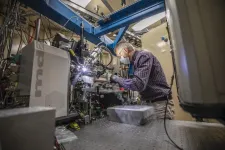(Press-News.org) A team of HIV researchers, cellular biologists, and biophysicists who banded together to support COVID-19 science determined the atomic structure of a coronavirus protein thought to help the pathogen evade and dampen response from human immune cells. The structural map - which is now published in the journal PNAS, but has been open-access for the scientific community since August - has laid the groundwork for new antiviral treatments tailored specifically to SARS-CoV-2, and enabled further investigations into how the newly emerged virus ravages the human body.
"Using X-ray crystallography, we built an atomic model of ORF8, and it highlighted two unique regions: one that is only present in SARS-CoV-2 and its immediate bat ancestor, and one that is absent from any other coronavirus," said lead author James Hurley, a UC Berkeley professor and former faculty scientist at Lawrence Berkeley National Laboratory (Berkeley Lab). "These regions stabilize the protein - which is a secreted protein, not bound to the membrane like the virus's characteristic spike proteins - and create new intermolecular interfaces. We, and others in the research community, believe these interfaces are involved in reactions that somehow make SARS-CoV-2 more pathogenic than the strains it evolved from."
Structural biology in the spotlight
Generating protein structure maps is always labor intensive, as scientists have to engineer bacteria that can pump out large quantities of the molecule, manipulate the molecules into a pure crystalline form, and then take many, many X-ray diffraction images of the crystals. These images - produced as X-ray beams bounce off atoms in the crystals and pass through gaps in the lattice, generating a pattern of spots - are combined and analyzed via special software to determine the location of every individual atom. This painstaking process can take years, depending on the complexity of the protein.
For many proteins, the process of building a map is helped along by comparing the unsolved molecule's structure to other proteins with similar amino acid sequences that have already been mapped, allowing scientists to make informed guesses about how the protein folds into its 3D shape.
But for ORF8, the team had to start from scratch. ORF8's amino acid sequence is so unlike any other protein that scientists had no reference for its overall shape, and it is the 3D shape of a protein that determines its function.
Hurley and his UC Berkeley colleagues, experienced in structural analysis of HIV proteins, worked with Marc Allaire, a biophysicist and crystallography expert at the Berkeley Center for Structural Biology, located at Berkeley Lab's Advanced Light Source (ALS). Together, the team worked in overdrive for six months - Hurley's lab generated crystal samples and passed them to Allaire, who would use the ALS's X-ray beamlines to take the diffraction images. It took hundreds of crystals with multiple versions of the protein and thousands of diffraction images analyzed by special computer algorithms to puzzle together ORF8's structure.
"Coronaviruses mutate differently than viruses like influenza or HIV, which quickly accumulate many little changes through a process called hypermutation. In coronaviruses, big chunks of nucleic acids sometimes move around through recombination," explained Hurley. When this happens, big, new regions of proteins can appear. Genetic analyses conducted very early in the SARS-CoV-2 pandemic revealed that this new strain had evolved from a coronavirus that infects bats, and that a significant recombination mutation had occurred in the area of the genome that codes for a protein, called ORF7, found in many coronaviruses. The new form of ORF7, named ORF8, quickly gained the attention of virologists and epidemiologists because significant genetic divergence events like the one seen for ORF8 are often the cause of a new strain's virulence.
"Basically, this mutation caused the protein to double in size, and the stuff that doubled was not related to any known fold," added Hurley. "There's a core of about half of it that's related to a known fold type in a solved structure from earlier coronaviruses, but the other half was completely new."
Answering the call
Like so many scientists working on COVID-19 research, Hurley and his colleagues opted to share their findings before the data could be published in a peer-reviewed journal, allowing others to begin impactful follow-up studies months earlier than the traditional publication process would have allowed. As Allaire explained, the all-hands-on-deck crisis caused by the pandemic shifted everyone in the research community into a pragmatic mindset. Rather than worrying about who accomplished something first, or sticking to the confines of their specific areas of study, scientists shared data early and often, and took on new projects when they had the resources and expertise needed.
In this case, Hurley's UC Berkeley co-authors had the viral protein and crystallography expertise, and Allaire, a longtime collaborator, was right up the hill, also with crystallography expertise and, critically, a beamline that was still operational. The ALS had received special funding from the CARES Act to remain operational for COVID-19 investigations. The team knew from reviewing the SARS-CoV-2 genomic analysis posted in January that ORF8 was an important piece of the (then much hazier) pandemic puzzle, so they set to work.
The authors have since all moved on to other projects, satisfied that they laid the groundwork for other groups to study ORF8 in more detail. (Currently, there are several investigations underway focused on how ORF8 interacts with cell receptors and how it interacts with antibodies, as infected individuals appear to produce antibodies that bind to ORF8 in addition to antibodies specific to the virus's surface proteins.)
"When we started this, other projects had been put on hold, and we had this unique opportunity to hunker down and solve an urgent problem," said Allaire, who is part of Berkeley Lab's Molecular Biophysics and Integrated Bioimaging Division. "We worked very closely, with a lot of back and forth, until we got it right. It really has been one of the best collaborations of my career."
INFORMATION:
Founded in 1931 on the belief that the biggest scientific challenges are best addressed by teams, Lawrence Berkeley National Laboratory and its scientists have been recognized with 14 Nobel Prizes. Today, Berkeley Lab researchers develop sustainable energy and environmental solutions, create useful new materials, advance the frontiers of computing, and probe the mysteries of life, matter, and the universe. Scientists from around the world rely on the Lab's facilities for their own discovery science. Berkeley Lab is a multiprogram national laboratory, managed by the University of California for the U.S. Department of Energy's Office of Science.
DOE's Office of Science is the single largest supporter of basic research in the physical sciences in the United States, and is working to address some of the most pressing challenges of our time. For more information, please visit energy.gov/science.
A new study published in the American Journal of Preventive Medicine found a 25% increase in food insufficiency during the COVID-19 pandemic. Food insufficiency, the most extreme form of food insecurity, occurs when families do not have enough food to eat. Among the nationally representative sample of 63,674 adults in the US, Black and Latino Americans had over twice the risk of food insufficiency compared to White Americans.
"People of color are disproportionately affected by both food insufficiency and COVID-19," said Jason Nagata, MD, MSc, assistant professor of pediatrics at the University of California, San Francisco and lead author on the study. "Many of these individuals have experienced job loss and higher rates of poverty during the ...
During April 2020, while the UK was in full lockdown, there was a drop of more than a third in the number of people seeking help for mental illness or self-harm according to research involving 14 million people registered at general practices across the four nations of the UK which was published today in The Lancet Public Health*.
The research, 'Effects of the COVID-19 pandemic on primary care-recorded mental illness and self-harm episodes in the UK: a population-based cohort study', was conducted by the National Institute for Health Research Greater Manchester Patient Safety Translational Research Centre (NIHR GM PSTRC). The Centre is a partnership between The University of Manchester and Salford Royal NHS Foundation ...
In a surprising discovery, Princeton physicists have observed an unexpected quantum behavior in an insulator made from a material called tungsten ditelluride. This phenomenon, known as quantum oscillation, is typically observed in metals rather than insulators, and its discovery offers new insights into our understanding of the quantum world. The findings also hint at the existence of an entirely new type of quantum particle.
The discovery challenges a long-held distinction between metals and insulators, because in the established quantum theory of materials, insulators were not thought to be able to ...
Reston, Virginia--Physicians who follow artificial intelligence (AI) advice may be considered less liable for medical malpractice than is commonly thought, according to a new study of potential jury candidates in the U.S. Published in the January issue of The Journal of Nuclear Medicine (JNM). The study provides the first data related to physicians' potential liability for using AI in personalized medicine, which can often deviate from standard care.
"New AI tools can assist physicians in treatment recommendations and diagnostics, including the interpretation of medical images," remarked Kevin Tobia, JD, PhD, ...
TORONTO, ON - New research led by researchers at the University of Toronto (U of T) and Northwestern University employs machine learning to craft the best building blocks in the assembly of framework materials for use in a targeted application.
The findings, published today in Nature Machine Intelligence, demonstrated that the use of artificial intelligence (AI) approaches can help in proposing novel materials for diverse applications. One example is the separation of carbon dioxide from industrial combustion processes. AI approaches promise the acceleration of the design cycle for materials.
With the objective of improving the separation of chemicals in industrial processes, the team of researchers - including collaborators from ...
'This effort truly represents a "moonshot" in COVID-19 research'
Scientists identify target to treat COVID pneumonia and reduce severity
Clinical trials with new experimental drug to begin early in 2021
Goal is to develop treatments that make COVID-19 no worse than a common cold
First comparison between immune mechanisms driving COVID-19 pneumonia with other pneumonias
CHICAGO --- Bacteria or viruses like influenza that cause pneumonia can spread across large regions of the lung over the course of hours. In the modern intensive care unit, these bacteria or viruses are usually controlled either by antibiotics or by the body's immune system within ...
How are networks of neurons connected to make functional circuits? This has been a long standing question in neuroscience. To answer this fundamental question, researchers from Boston Children's Hospital and Harvard Medical School developed a new way to study these circuits and in the process learn more about the connections between them.
"Neural networks are extensive, but the connections between them are really small," says Wei-Chung Allen Lee, PhD, of the F.M. Kirby Neurobiology Center at Boston Children's and Harvard Medical School. "So, we have had to develop techniques to see them in extremely high-resolution over really large areas and volumes." ...
ORLANDO, Jan. 11, 2021 - Data from Arecibo Observatory in Puerto Rico has been used to help detect the first possible hints of low-frequency disturbances in the curvature of space-time.
The results were presented today at the 237th meeting of the American Astronomical Society, which was held virtually, and are published in The Astrophysical Journal Letters. Arecibo Observatory is managed by the University of Central Florida for the National Science Foundation under a cooperative agreement.
The disturbances are known as gravitational waves, which ripple through space as a result of the movement of incredibly massive objects, such as black holes orbiting one another or the collision of neutron stars.
It's important to understand these waves as they provide insight into the history ...
CAMBRIDGE, MA -- When we experience a new event, our brain records a memory of not only what happened, but also the context, including the time and location of the event. A new study from MIT neuroscientists sheds light on how the timing of a memory is encoded in the hippocampus, and suggests that time and space are encoded separately.
In a study of mice, the researchers identified a hippocampal circuit that the animals used to store information about the timing of when they should turn left or right in a maze. When this circuit was blocked, the mice were unable to remember which way they were supposed to turn next. However, disrupting the circuit ...
North Carolina State University-led researchers have developed an analytical measurement "framework" which could allow organic solar cell researchers and manufacturers to determine which materials will produce the most stable solar cells prior to manufacture.
Organic solar cells have increased in efficiency over the past decades, but researchers and manufacturers still struggle with determining which material combinations work best and why, as well as with achieving stable morphology and operation.
"There is still a lot of 'trial and error' guesswork involved in identifying promising materials for these solar cells," says Harald Ade, Goodnight Innovation Distinguished Professor of Physics at NC State and co-corresponding author of the research. ...


